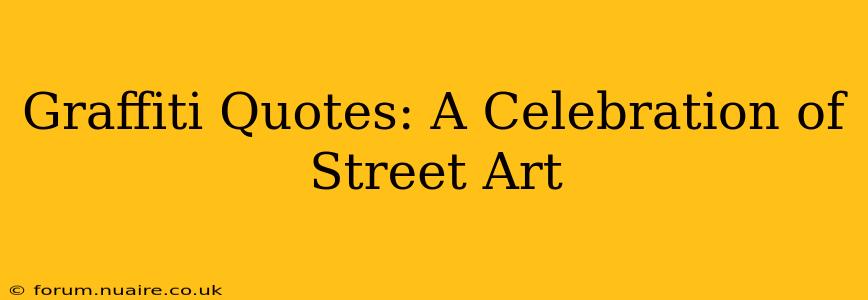Graffiti art, often misunderstood and dismissed as vandalism, is a powerful form of self-expression with a rich history. From bold political statements to intricate murals showcasing breathtaking artistry, graffiti quotes offer a glimpse into the minds and experiences of the artists who create them. This exploration dives into the world of graffiti quotes, examining their meaning, impact, and enduring legacy. We'll also answer some frequently asked questions about this captivating art form.
What Makes Graffiti Quotes Unique?
Graffiti quotes stand apart from other forms of art due to their ephemeral nature and the inherent risk involved in their creation. Unlike gallery paintings or commissioned murals, graffiti often appears unexpectedly in public spaces, transforming urban landscapes and challenging conventional notions of art. The immediacy and often rebellious spirit of these quotes lend them a raw energy and authenticity that's captivating. The choice of location – a hidden alleyway, a bustling city street, or a forgotten building – adds another layer to the message, shaping how the audience interacts with the art.
Are Graffiti Quotes Considered Vandalism?
This is a complex question. While many view graffiti as vandalism, destroying property and defacing public spaces, others see it as a vibrant form of public art, expressing social commentary or simply showcasing artistic talent. The legality and acceptance of graffiti often depend on several factors: the location, the nature of the artwork, and local regulations. Some cities have designated "graffiti walls" or areas where street artists can legally express themselves, while others strictly prohibit any unauthorized artwork on public or private property. The intention behind the artwork also plays a role. A politically charged statement might be seen differently than a simple tag. Ultimately, the line between art and vandalism is subjective and context-dependent.
What are some famous graffiti quotes?
Many famous graffiti quotes are less about specific wording and more about the artist's style and overall message. Banksy, for instance, is known for his satirical and thought-provoking street art, often employing imagery and symbolism rather than explicit quotes. However, the impact of his work often speaks volumes, prompting reflection and discussion on social and political issues. Other artists utilize powerful phrases and slogans, adapted from existing literature or reflecting contemporary concerns. These quotes, often brief and impactful, are designed to resonate with the viewer and spark conversation. Finding specific, widely known "quotes" is difficult, as many pieces are more visual than textual.
How do graffiti artists choose their locations?
The selection of a location for graffiti is a strategic decision. Artists consider several factors, including visibility, accessibility, and the potential impact of their artwork. High-traffic areas allow for maximum exposure, but they also increase the risk of detection and arrest. Hidden alleys or less-accessible locations might offer more privacy but sacrifice visibility. The background and surroundings also play a role; some artists seek complementary backgrounds to enhance their work, while others deliberately choose contrasting settings to create a juxtaposition or ironic statement. The overall goal is to maximize the art's impact and message, carefully considering the interplay between location and content.
What are the legal implications of graffiti art?
The legal implications of graffiti vary significantly based on location and local ordinances. Unauthorized graffiti is generally considered vandalism and can result in fines, community service, or even jail time. However, the penalties can differ greatly depending on the severity of the offense, the value of the damaged property, and the artist's prior record. Some cities have implemented programs that encourage legal graffiti art, providing designated spaces for artists to express themselves while avoiding legal repercussions. It's crucial to understand local laws and regulations before engaging in any graffiti activity.
The Enduring Power of Graffiti Quotes
Graffiti quotes, with their blend of rebellion, artistry, and social commentary, continue to capture the public imagination. They challenge our perceptions of art, public space, and even the very definition of vandalism. By exploring the meaning and context of these often-overlooked works, we gain a deeper understanding of urban culture, social justice movements, and the power of self-expression. The ephemeral nature of much graffiti lends it a unique immediacy, prompting viewers to reflect on the messages and artistry found within their fleeting existence.

